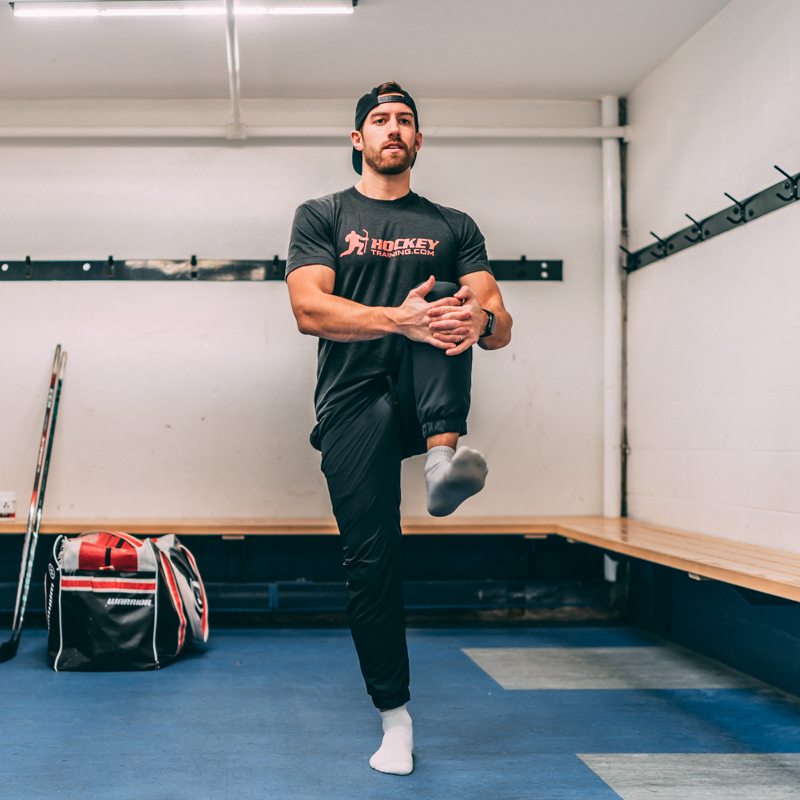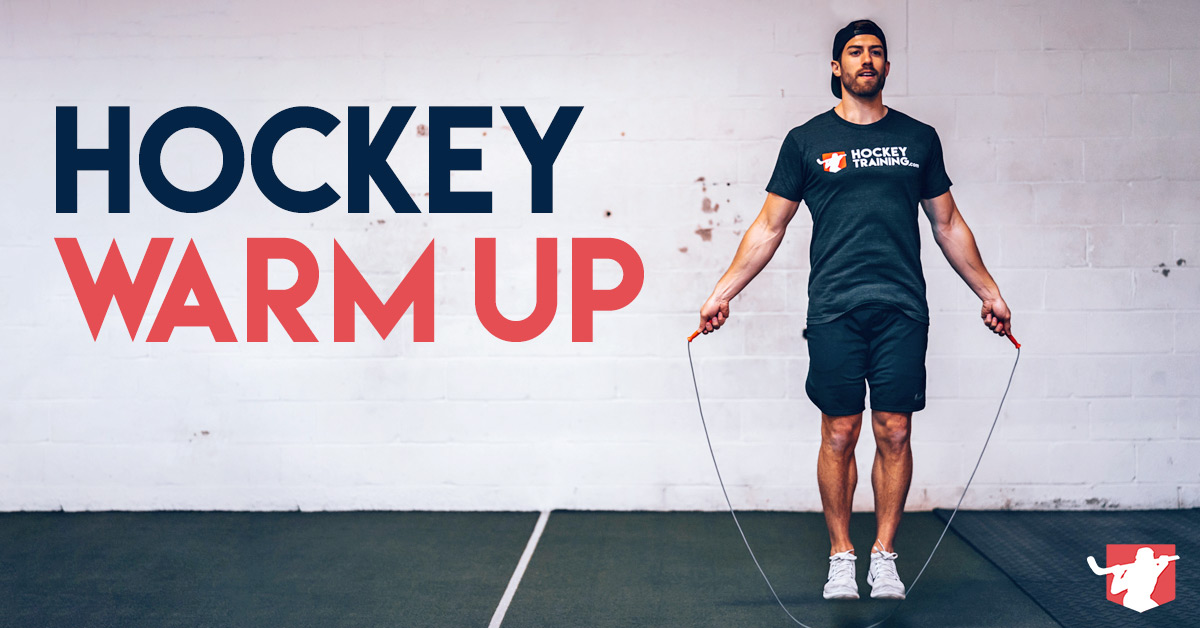Whether it’s a big game or just a practice, warming up the right way can make a huge difference in how you feel and perform on the ice.
Unfortunately, most players either skip warm-ups entirely or rely on outdated routines that do little to actually prepare their body or mind for hockey’s demands.
In this guide, I’ll show you the perfect hockey warm-up system, broken into three key parts:
- What to do before you put on your gear
- What to focus on once you hit the ice
- And why this approach isn’t just about injury prevention, it’s your secret weapon for peak performance
Whether you’re a player, coach, or parent looking for the best way to prep for the game, this guide will help you warm up smarter and play better.
Activate Your Hands: Stickhandling Warm-Up (Anytime)
When to do it: Before getting dressed (up to 30 minutes before hitting the ice, or even earlier that day)
Duration: 5–10 minutes
What it targets: Hand speed, puck control, vision, coordination, and mental focus
Stickhandling before you get dressed gets your hands, eyes, and brain firing. It also helps you tap into your “hockey feel” before even stepping on the ice.
How to do it:
- Start with basics: side-to-side stickhandling, front-to-back movements on both sides
- Progress to figure 8s, toe pulls, and curvilinear movement
- Finish with visualization: act out 1-on-1 dekes and high-speed moves
💡 Tip: Visualizing game scenarios while moving your hands activates the same neural pathways used during actual play. You’re warming up your instincts, not just your muscles.
Prime Your Body: Full Dynamic Warm-Up (Before You Dress)
When to do it: Before getting your equipment on
Duration: 5–10 minutes
What it targets: Mobility, stability, muscle activation, core temperature, and nervous system readiness
A dynamic warm-up is essential for priming your body for explosive skating and avoiding injury.
I have two options for you:
Option 1: Follow-Along Video (No Thinking Needed)
If you want to press play and warm up with me step-by-step, this video walks you through the full routine:
Option 2: Self-Paced Routine (No Screen Required)
If you’d rather do it on your own without following a video, here’s the full warm-up you can run through at your own pace:
Here are the exercises we ran through in the above warm-up:
- Zombie Lateral Lunge x 5 per side
- Jumping Jacks x 30
- T-Stab Push-Ups x 6 per side
- Arm Circles x 12 in each direction
- Straight Arm Rotations x 8 per side
- Single-Leg Hip Circle x 12 in each direction per leg
- Zombie Squat With Reach Through x 8
- Shoulder T x 15
Sharpen Your Skills: Smart On-Ice Warm-Up Strategies
When to do it: During team warm-ups on the ice
Duration: 5–20 minutes
What it targets: Skating, puck touch, edge control, and game readiness
Don’t waste your team’s on-ice warm-up time just going through the motions. Use this time to dial in your movement, timing, and feel for the puck and your edges.
What to focus on:
- Focus on your skating mechanics, including crossovers, edge control, mohawks, quick starts, and transitions, to get your feet under you.
- Add in stickhandling reps with changes in direction and speed to sharpen your touch and hand-eye coordination.
- Get shots off from multiple angles and locations, simulating game-like situations. Don’t just fire pucks mindlessly.
These reps set the tone for your first shift, physically and mentally. If you treat the warm-up like a walkthrough, you’ll likely start slow. But if you treat it like a preview of your performance, you’ll hit the ice ready to compete from the opening faceoff.
Why Warm-Ups Matter: The Science Behind Better Hockey Performance

The two biggest reasons to warm up properly before hockey are injury prevention and performance enhancement, and both come down to how your body responds when it’s physically and neurologically prepared for action.
Here’s what a proper warm-up does behind the scenes:
- Muscles contract more forcefully and relax faster, which directly boosts your speed, power, agility, and strength.
- Nerve signals fire more efficiently, improving reaction time and overall coordination—this is often referred to as “waking up the nervous system.”
- Blood temperature rises, improving oxygen delivery to muscles and enhancing endurance.
- Vasodilation increases, allowing more fuel (such as carbohydrates and electrolytes) to enter working muscles and helping to remove waste products like lactic acid more efficiently.
- Mobility and joint range of motion improve, reducing stiffness and injury risk while helping you move more freely in real game situations.
In short, almost every physical advantage you want—quicker reactions, more explosive strides, harder shots—relies on raising your body temperature and priming your nervous system. Yet despite this, warm-ups are often rushed or overlooked by players (and even coaches) who don’t realize how much performance they’re leaving on the table.
If you want to perform at your best, a proper warm-up isn’t optional—it’s a competitive advantage.
Final Thoughts
Take your on-ice warm-up time seriously!
Many hockey players just “go through the motions” of a warm-up without actually focusing on getting the body prepared for the game (which is why some players and teams start slow).
By incorporating a general warm-up before putting on your equipment and a specific warm-up when you’re on the ice, you should be 100% ready to play at full speed at the drop of the puck.
Ready to take your game to the next level?
If you want to train smarter, skate faster, and become the best hockey player you can be start by finding the right program for your goals.
Click here to use our free Program Selector Tool to get started today.
It only takes a minute, and you’ll get a personalized recommendation based on your age, skill level, and hockey goals.
Frequently Asked Hockey Warm-Up Questions
Ideally, a dynamic hockey warm-up would be done 10-15 minutes before hitting the ice.
To perform your best, start by staying hydrated and eating well in the 24–48 hours leading up to the game. On game day, give yourself time to go through a proper off-ice warm-up before getting dressed. This should include light stickhandling and a dynamic warm-up to activate your muscles, increase mobility, and mentally prepare for the ice.
Yes, but not static stretching. Before a hockey game, you should focus on dynamic stretching and movement-based exercises that warm up your muscles, increase mobility, and get your body ready for fast-paced movement. Save static stretching (long holds) for after the game or during your cool-down, when the goal is recovery and flexibility, not performance.
Before a hockey game, aim to eat a balanced meal 2–3 hours beforehand that includes lean protein, complex carbs, and a small amount of healthy fat. For example, 6oz chicken breast, 1-2 cups of brown rice, and ½ – 1 cup of green vegetables. Make sure to sip water steadily on game day and arrive well-hydrated. Dehydration can hurt your endurance, strength, and focus on the ice.

